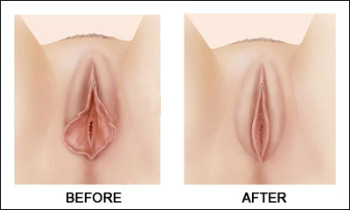Labiaplasty
Labia minora and majora may have different shape and appearance in women, which is usually present secondary to genetics or due to other factors such as hormonal, environmental, time (age) or a childbirth. Abnormally shaped, asymmetrical or larger labia may lead to the following conditions in women: dissatisfaction because of an inability to wear certain type (tight clothing), frequent urinary tract infections, recurrent vaginal or vulvar infections or simply not cosmetically accepted appearance. Labiaplasty procedure can be performed to correct asymmetrical and enlarged labia.
Labia Minora: very often the structures (labia minora) can be too large or asymmetric resulting in recurrent urinary tract infections, discomfort or unacceptable appearance for the patient. Many of our patients experience chronic infections due to an enlarged labia: therefore they may gain relief from this procedure
Cosmetic gynecology enhancement is generally for the overall appearance of the labia by reducing the size of the labia or by restoring any asymmetry.
Labiaplasty Procedures: Reshapes and contours the appearance of the labia minora (small lips) or labia majora (large lips).
Labia minora-Labiaplasty, is a corrective procedure which can be performed to enhance more ecstatically pleasing appearance or to eliminate many medical conditions.
Surgical correction of labia minora abnormalities is an established procedure for women who are not satisfied with the appearance of their external genitalia or have certain medical conditions. Labia majora procedures are mainly performed for women who loose the elasticity and shape of the structure with aging or weight changes.
Labia Minora with Clitoral Hoodoplasty: the surgical procedure is usually performed to expose covered clitoral area by a prepuce (a skin fold covering the clitoris). The skin fold is also called clitoral hood or clitoral foreskin; therefore clitoral hoodectomy.
The reductive hoodoplasty is a surgery which is performed to decrease the excessive skin of the clitoral perpetual tissue or to reduce the uneven thickness of the clitoral hood. A careful technique is used to preserve the neurological function of the structure.
Labia Majora- the large lip may undergo anatomical changes throughout the years because of aging, loss in tissue laxity, loss of fatty tissue, and vaginal deliveries. As a result, the structure may have asymmetrical, wrinkled, not aesthetically pleasing appearance.
Labia majora restoration: is a surgical intervention to restore the shape of the structure. The procedure can be performed in many ways depending on the anatomical changes and amount of excessive skin and fat tissue. The end result is to have a youthful labia without excessive and stretched skin overlying this structure.
Labia majora reshaping: in women where the amount of fat tissue is significantly decreased one can consider autologous fat transfer. The procedure involves transfer of your own fat from area to another using an established technique.
What to expect during the process of evaluation and treatment:
1. Extensive preoperative consultation and assessement of patient’s desires and expectations
2. Determination of the most appropriate and feasible labiaplsty technique tailored to patient desires and needs
3. Counseling regarding possible outcomes regardless of technique applied
4. Postoperative instructions with emphasis on pain management, swelling, and recovery time
5. Longterm recovery time, return to work and regular physical activities
What is labiaplasty?
Labiaplasty is a corrective procedure of labia minora (inner lip) or labia majora (outer lip) which can be performed to enhance a more ecstatically pleasing appearance of the structures or to eliminate many symptoms and/or medical conditions. The most common type of procedure is to decrease the size and/or reshape the labia structure. Occasionally if there is asymmetry present, one labia may be trimmed to provide more acceptable appearance.
Statistics reveal that 1/3 of women have the procedure performed for aesthetic indications, 1/3 for medical , and the remaining 1/3 for both.
Who is a candidate for the procedure?
Surgical correction of labia minora or majora abnormalities is an established procedure for women who are not satisfied with the appearance of their external genitalia or have certain medical conditions. If any of these occur, any woman can seek labiaplasty procedure. Frequently, enlarged or anatomically altered labia minora or majora may contribute to recurrent urinary tract infections, vaginal infections, pain during intercourse, or lack of confidence. All of above can be discussed with the physician to address the concerns.
Are there different techniques to perform labiaplasty?
Yes essentially there are many different techniques to perform the procedure. All surgical options will be discussed during your initial consultation. This will mainly depend on the desire to retain the natural pigment of the labia edges or a new pink color. In patients who desire a natural look, a wedge technique is utilized.
What is clitoral hodectomy?
Clitoral hood (prepuce) is a skin tissue covering the female clitoris. Some women may have to long or wide tissue overlying the hood which may lead to collection of secretions and frequent infections ot may affect sexual experience.
The procedure includes removal of excess skin to partially expose the clotoris.
Can clitoral hodectomy it be performed in conjunction with other procedures? Usually is performed in conjunction with labiaplasty.
What is the recovery time after labiaplasty?
It will depend on the extend and type of the procedure and if it was performed in conjunction with other surgeries such as vaginal rejuvenation.
Most patients may resume routine daily activities 48 hours after the surgery and return to work 1 week after the procedure. It usually takes 6-8 weeks for the sutures to reabsorbe. Physical exercise or strenous activity may ne resumed 4 weeks after labiaplasty.
What is the recovery time after labiaplasty?
It will depend on the extend and type of the procedure and if it was performed in conjunction with other surgeries such as vaginal rejuvenation.
Most patients may resume routine daily activities 48 hours after the surgery and return to work 1 week after the procedure. It usually takes 6-8 weeks for the sutures to reabsorbe. Physical exercise or strenous activity may ne resumed 4 weeks after labiaplasty.


